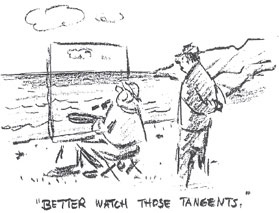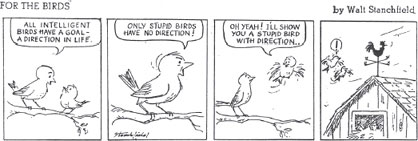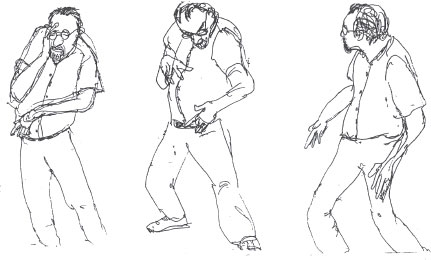It is mighty tempting to go on making humorous handouts but I’m not getting paid to entertain you — I’m supposed to be broadcasting the good news about good drawing. However, here’s a spin off from last week’s handout. I didn’t have room for this cartoon and someone who saw it said, “Hey, you could do a whole handout on tangents.” I was tempted to try, but…well, here is the cartoon.

The main thrust of my teaching is that you have to have a motive for drawing — a story to illustrate. Something to give you direction. And yet, here in one episode of a cartoon strip, For the Birds, which I did years ago, that notion is overruled.

But I do believe we should be eternally flexible. We should never be so sure of ourselves that our minds are closed to new ideas:

The best kind of learning is the kind that teaches you to think, that way you don’t have to rely on anyone else, or on formulas.

In the evening classes I try to make it clear that I am not “correcting” a person’s work by using my version of how the drawing should look. I’m trying to help find better ways of seeing gestures and actions. As Don Graham used to say in a painting class at Chouinard’s (Chouinard Art Institute which later became Cal Arts), after criticizing a painting, “So what! It could have been done a hundred different ways, and all of them could have been good.” The idea was to open up the mind to possibilities and not to be satisfied with whatever happened to cone out, but to be able to consciously choose and guide the outcome.
Here is a student’s drawing that is quite loose (something I encourage), but seems to lack the artist’s wholehearted involvement in the gesture. An artist is “on stage” just like an actor in a play. He can’t just “make a drawing”; that is, put down the proper number of legs and arms, etc. He has to make them “do” something …“act”. He has to have a dramatic or a humorous point to put over, and must use all the principles of drawing at his command to put it over.
In this pose, Craig Howell was a gardener, probably cleaning the leaves out of his rake (I forget). The student’s drawing seemed a bit passive, so I added a thrust of energy from his feet right up to the rake. The whole left side of his body became a stretch, causing the right side to be a squash. I dropped his left foot and the belt on the left side so they would pull away from the upraised shoulder. I got the hand out where you could see what it was doing and exposed the face so he could see what he was doing. I angled the whole body toward the center of interest, which was the rake:

You’ve heard me speak over and over again about straightening things up. Here the student has straightened up the torso, the arms, and the hands. I suggested that the gardener would lean into whatever he was doing, bending forward from the waist. To guide the attention downward to the cutter, I lowered his left hand. See the triangle it creates between the two hands and the face. It sets up a downward movement in the direction of the cutters. His right hand’s higher, which calls for the right elbow and shoulder to be higher, eliminating a sameness of angles, and sets up a tension as if he were pushing on the cutter handles.

And speaking of straightening things up, here was a pose with lots of tension in it. The artist knows his anatomy; that is, how to draw arms, legs, waists, hips, etc., but failed to work those parts into what was a very expressive pose. Notice that he straightened up the body by making the hands, buttocks, knees, and feet horizontally parallel.

As you can see, anatomy is not the answer — acting is. If anatomy were the answer, an actor could go out on the stage and just stand there naked. The inner motivations that power a person’s body to express body language is what it’s all about. Anatomy is what is on the outside — motivation is the driving force within. That’s what the gesture classes and these handouts are for. They’re to whet your desire to go beyond just an anatomical drawing (or a copy of the model); to foment a life-long desire to express readable emotions in your drawings and to stimulate your inner forces to take over and rule the outer. May the INNER FORCE be with you!
To show what can be done through that inner seeing/feeling, here are some drawings by Dylan Kohler, who has never attended an anatomy class. There’s no doubt about what’s going on story-wise. (Mike Swofford gave us a whole evening of such great poses.) I have encouraged Dylan to learn anatomy but only to “tighten” up his drawing, but to be careful that it doesn’t “stiffen” up his gestures. Incidentally, these are not timid attempts — they are an impressive seventeen inches high.

